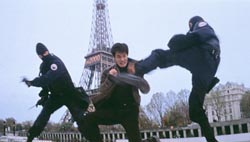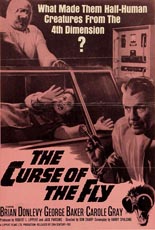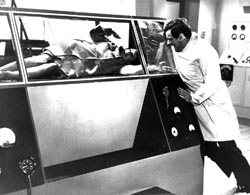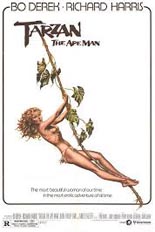
 Your first sign that John Derek’s Tarzan, the Ape Man is the legendary bungle in the jungle as reputed: the film’s literal first image, of MGM’s iconic Leo the Lion opening his mouth to emit that famous growl … only to be overdubbed by that old-school Tarzan yell.
Your first sign that John Derek’s Tarzan, the Ape Man is the legendary bungle in the jungle as reputed: the film’s literal first image, of MGM’s iconic Leo the Lion opening his mouth to emit that famous growl … only to be overdubbed by that old-school Tarzan yell.
Set in 1910, this adventure of Edgar Rice Burroughs’ most lucrative literary cash cow focuses on Jane (Bo Derek, the director’s wife), a blonde-haired, blue-eyed beauty with sun-kissed cheeks who has come to West Africa to find the father she’s never known. He’s James Parker (Richard Harris, Gladiator), an eccentric explorer who’s somewhat of an elephant whisperer and completely a “first-class bastard.” Jane joins his expedition to bond.
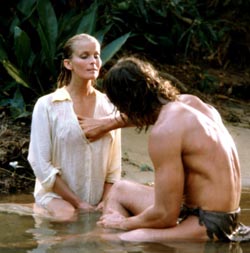 Forty-five minutes in, Mr. Derek finally gives his audience what they want: Tarzan and tits. The two (three?) elements arrive in the same scene, as a bathing Jane is threatened by a lion (this one growls in its own voice), yet saved by Tarzan (Miles O’Keeffe, Sword of the Valiant) — a putative half-man/half-ape, James warns his daughter. James wants to capture and stuff the feral man; Jane wants to be stuffed by him. Because children do the opposite of their parents’ wishes, a grateful Jane lets the mute Tarzan feel her up. Somewhere, Rosie the Riveter weeps.
Forty-five minutes in, Mr. Derek finally gives his audience what they want: Tarzan and tits. The two (three?) elements arrive in the same scene, as a bathing Jane is threatened by a lion (this one growls in its own voice), yet saved by Tarzan (Miles O’Keeffe, Sword of the Valiant) — a putative half-man/half-ape, James warns his daughter. James wants to capture and stuff the feral man; Jane wants to be stuffed by him. Because children do the opposite of their parents’ wishes, a grateful Jane lets the mute Tarzan feel her up. Somewhere, Rosie the Riveter weeps.
Acting as his own cinematographer, Mr. Derek photographs his spouse as if everyone wants to bed her. And back then, millions did; they just didn’t see the need to pay for it when there was a perfectly good Playboy tie-in pictorial awaiting back home. Thus, Tarzan, the Ape Man died on the vine, putting out the fire kindled just two years earlier, when Blake Edwards’ 10 made Bo an overnight sex symbol, despite those godawful cornrows.
The spouses’ Tarzan collaboration is a laughable, misguided exercise in ego-fluffing, nipple-tweaking and monkey-loving. Its opening suggests grand-scale prestige; its comic-book transitions promise something pulpy; and the finished product is neither. Keeping O’Keeffe quiet was a move for the best, but giving Bo the lion’s share of dialogue was asking for it. As if to compete with the “scenery” for attention, Harris makes sweeping gestures with his arms as he shouts his lines.
All that limb flailing counts as the most (nonsexual) action the movie achieves. Mr. Derek squanders a dandy sequence in which Jane is embraced by a deadly python, and it’s Tarzan to the rescue! But in slow-motion — so slow, the serpent could have been a puppet. So could O’Keeffe. Him Tarzan; Bo Jane; you bored. —Rod Lott

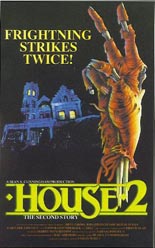

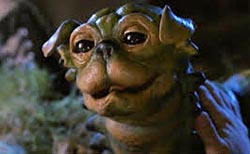
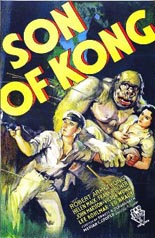
 No sane person can dispute the incredible craftsmanship of 1933’s
No sane person can dispute the incredible craftsmanship of 1933’s 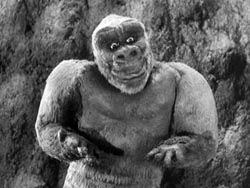
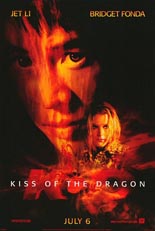
 One year after
One year after 